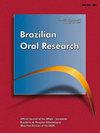Pathways that explain racial differences on edentulism among older adults: 2019 Brazil National Health Survey.
IF 2.5
4区 医学
Q2 Dentistry
引用次数: 0
Abstract
This study aimed to evaluate the pathways that explain the association between race/skin color and edentulism in elderly Brazilians. This was a cross-sectional study using data from participants aged 60 years or older from the 2019 Brazilian National Health Survey, a nationally representative population-based sample. Data were obtained by a structured interview and participants were classified as edentulous if they reported having lost all natural teeth. Information on race, socioeconomic level, behavioral aspects, psychosocial aspects, and access to dental care was collected by interviewers using a questionnaire. The pathways between race/skin color and edentulism were analyzed using structural equation modeling. The final sample of the study included 22,357 participants. Most participants were white (51.5%; 95% confidence interval [CI]: 50.3-52.6), and 36.8% (95%CI: 35.7-37.9) were edentulous. Race/skin color was indirectly associated with edentulism via enabling factors. These findings suggest that socioeconomic inequalities are key in explaining racial inequalities in edentulism among Brazilian older adults.解释老年人牙齿发育的种族差异的途径:2019年巴西国家健康调查。
本研究旨在评估解释种族/肤色与巴西老年人牙齿发育之间关系的途径。这是一项横断面研究,使用了2019年巴西国家健康调查中60岁及以上参与者的数据,这是一项具有全国代表性的基于人群的样本。数据是通过结构化访谈获得的,如果参与者报告失去了所有的天然牙齿,他们就被归类为无牙者。访谈者使用问卷收集了种族、社会经济水平、行为方面、心理方面和获得牙科保健的信息。采用结构方程模型分析了种族/肤色与牙齿发育之间的关系。该研究的最终样本包括22357名参与者。大多数参与者是白人(51.5%;95%可信区间[CI]: 50.3 ~ 52.6),无牙率为36.8% (95%CI: 35.7 ~ 37.9)。种族/肤色通过使能因素与牙髓症间接相关。这些发现表明,社会经济不平等是解释巴西老年人长牙症的种族不平等的关键。
本文章由计算机程序翻译,如有差异,请以英文原文为准。
求助全文
约1分钟内获得全文
求助全文
来源期刊

Brazilian Oral Research
DENTISTRY, ORAL SURGERY & MEDICINE-
CiteScore
3.70
自引率
4.00%
发文量
107
审稿时长
12 weeks
 求助内容:
求助内容: 应助结果提醒方式:
应助结果提醒方式:


